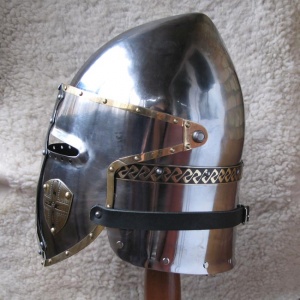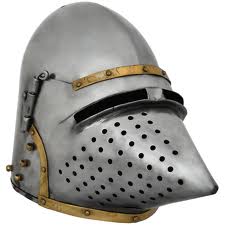Does anybody know if it is historically accurate to have leather tie-back straps on the visor of a bascinet? Specifically, leather straps that were attached to the bottom corners of the visor itself that, when the visor was lowered into the down position, the straps were then wrapped around the main body of the helm and tied or buckled at the back. The idea supposedly being to keep the visor locked in the down position, eliminating the chance of the visor flying up during usage/combat?
I have recently purchased a visored bascinet from steel-mastery, and a number of their helms appear to include this feature (that they term "visor back fixation"). Mine has this as well.
If these straps have no historical basis, I'll remove them. I have included a photo of this idea.
Thanks in advance for any insight.
Brett
[/img]

Photo of a visored bascinet with visor tie-back straps in the tied position
